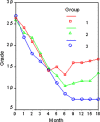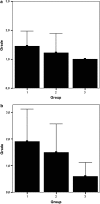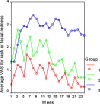Treatment of acne with intermittent and conventional isotretinoin: a randomized, controlled multicenter study
- PMID: 17710426
- PMCID: PMC2094720
- DOI: 10.1007/s00403-007-0777-2
Treatment of acne with intermittent and conventional isotretinoin: a randomized, controlled multicenter study
Abstract
Oral isotretinoin is the most effective choice in the treatment of severe acne. Application of isotretionin to acne has been expanded to treat those patients with less severe but scarring acne who are responding unsatisfactorily to conventional therapies. However, its use is associated with many side effects, some of which can result in very disastrous consequences. Data related with intermittent isotretinoin therapy is still limited. Our aim was to asses the efficacy and tolerability of two different intermittent isotretinoin courses and compare them with conventional isotretinoin treatment. In this multicenter and controlled study, 66 patients with moderate to severe cases were randomized to receive either isotretionin for the first 10 days of each month for 6 months (group 1), or each day in the first month, afterwards the first 10 days of each month for 5 months (group 2) or daily for 6 months (group 3). The drug dosage was 0.5 mg/kg/day in all groups. Patients were followed-up for 12 months. Efficacy values were evaluable for 22 patients in group 1, 19 patients in group 2, and 19 patients in group 3. Acne scores in each group were significantly lower at the end of treatment and follow-up periods (P < 0.001). When patients were evaluated separately as moderate (n = 31) and severe (n = 29), no statistically significant differences were obtained among the treatment protocols in patients with moderate acne. However, there was a significant difference between groups 1 and 3 to the response of the treatments in severe acne patients at the end of follow-up period (P = 0.013). The frequency and severity of isotretionin-related side effects were found to be lower in groups 1 and 2 compared with group 3. Intermittent isotretinoin may represent an effective alternative treatment, especially in moderate acne with a low incidence and severity of side effects. The intermittent isotretinoin can be recommended in those patients not tolerating the classical dosage.
Figures





Similar articles
-
Effectiveness of conventional, low-dose and intermittent oral isotretinoin in the treatment of acne: a randomized, controlled comparative study.Br J Dermatol. 2011 Jun;164(6):1369-75. doi: 10.1111/j.1365-2133.2010.10152.x. Epub 2011 May 17. Br J Dermatol. 2011. PMID: 21114478 Clinical Trial.
-
Comparison of the efficacies of intermittent and continuous low-dose isotretinoin regimens in the treatment of moderate acne vulgaris.Int J Dermatol. 2013 Oct;52(10):1265-7. doi: 10.1111/j.1365-4632.2012.05853.x. Epub 2013 May 15. Int J Dermatol. 2013. PMID: 23675954 Clinical Trial.
-
The effectiveness of intermittent isotretinoin treatment in mild or moderate acne.J Eur Acad Dermatol Venereol. 2006 Nov;20(10):1256-60. doi: 10.1111/j.1468-3083.2006.01784.x. J Eur Acad Dermatol Venereol. 2006. PMID: 17062042 Clinical Trial.
-
Isotretinoin (roaccutane) usage--a South African consensus guideline. National Dermatology Working Group.S Afr Med J. 1997 Oct;87(10 Pt 2):1410-3. S Afr Med J. 1997. PMID: 11496385 Review.
-
The role of isotretinoin in acne therapy: why not as first-line therapy? facts and controversies.Clin Dermatol. 2010 Jan-Feb;28(1):24-30. doi: 10.1016/j.clindermatol.2009.03.005. Clin Dermatol. 2010. PMID: 20082946 Review.
Cited by
-
[Drug therapy of acne].Hautarzt. 2008 Jul;59(7):579-89; quiz 590. doi: 10.1007/s00105-008-1498-y. Hautarzt. 2008. PMID: 18535811 Review. German.
-
Efficacy and safety of combined oral isotretinoin and desloratadine vs. isotretinoin alone in acne vulgaris: a comparative study.Arch Dermatol Res. 2025 Apr 10;317(1):689. doi: 10.1007/s00403-025-04145-7. Arch Dermatol Res. 2025. PMID: 40204949 Clinical Trial.
-
Comparing the frequency of isotretinoin-induced hair loss at <0.5-mg/kg/d versus ≥0.5-mg/kg/d dosing in acne patients: A systematic review.JAAD Int. 2022 Feb 10;6:125-142. doi: 10.1016/j.jdin.2022.01.002. eCollection 2022 Mar. JAAD Int. 2022. PMID: 35199047 Free PMC article. Review.
-
Oral isotretinoin for acne.Cochrane Database Syst Rev. 2018 Nov 24;11(11):CD009435. doi: 10.1002/14651858.CD009435.pub2. Cochrane Database Syst Rev. 2018. PMID: 30484286 Free PMC article.
-
Safety and efficacy of low-dose isotretinoin in the treatment of moderate to severe acne vulgaris.Indian J Dermatol. 2014 May;59(3):316. doi: 10.4103/0019-5154.131455. Indian J Dermatol. 2014. PMID: 24891681 Free PMC article.
References
-
- {'text': '', 'ref_index': 1, 'ids': [{'type': 'PubMed', 'value': '12928552', 'is_inner': True, 'url': 'https://pubmed.ncbi.nlm.nih.gov/12928552/'}]}
- Amichai B (2003) Long-term minidoses of isotretinoin in the treatment of relapsing acne. J Dermatol 30:572 - PubMed
-
- {'text': '', 'ref_index': 1, 'ids': [{'type': 'DOI', 'value': '10.1016/j.jaad.2005.11.1061', 'is_inner': False, 'url': 'https://doi.org/10.1016/j.jaad.2005.11.1061'}, {'type': 'PubMed', 'value': '16546586', 'is_inner': True, 'url': 'https://pubmed.ncbi.nlm.nih.gov/16546586/'}]}
- Amichai B, Shemer A, Grunwald MH (2006) Low-dose isotretinoin in the treatment of acne vulgaris. J Am Acad Dermatol 54:644–646 - PubMed
-
- {'text': '', 'ref_index': 1, 'ids': [{'type': 'DOI', 'value': '10.1067/S0190-9622(03)01153-8', 'is_inner': False, 'url': 'https://doi.org/10.1067/s0190-9622(03)01153-8'}, {'type': 'PubMed', 'value': '12963898', 'is_inner': True, 'url': 'https://pubmed.ncbi.nlm.nih.gov/12963898/'}]}
- Cunliffe WJ, Meynadier J, Alirezai M et al (2003) Is combined oral and topical therapy better than oral therapy alone in patients with moderate to moderately severe acne vulgaris? A comparison of the efficacy and safety of lymecycline plus adapalene gel 0.1%, versus lymecycline plus gel vehicle. J Am Acad Dermatol 49:218–226 - PubMed
-
- {'text': '', 'ref_index': 1, 'ids': [{'type': 'PubMed', 'value': '11701404', 'is_inner': True, 'url': 'https://pubmed.ncbi.nlm.nih.gov/11701404/'}]}
- Gollnick HP, Graupe K, Zaumseil RP (2001) Comparison of combined azelaic acid cream plus oral minocycline with oral isotretinoin in severe acne. Eur J Dermatol 11:538–544 - PubMed
-
- {'text': '', 'ref_index': 1, 'ids': [{'type': 'DOI', 'value': '10.1046/j.1365-2133.1997.17771864.x', 'is_inner': False, 'url': 'https://doi.org/10.1046/j.1365-2133.1997.17771864.x'}, {'type': 'PubMed', 'value': '9274635', 'is_inner': True, 'url': 'https://pubmed.ncbi.nlm.nih.gov/9274635/'}]}
- Goulden V, Clark SM, Mcgeown C, Cunliffe WJ (1997) Treatment of acne with intermittent isotretinoin. Br J Dermatol 137:106–108 - PubMed
Publication types
MeSH terms
Substances
LinkOut - more resources
Full Text Sources
Medical

